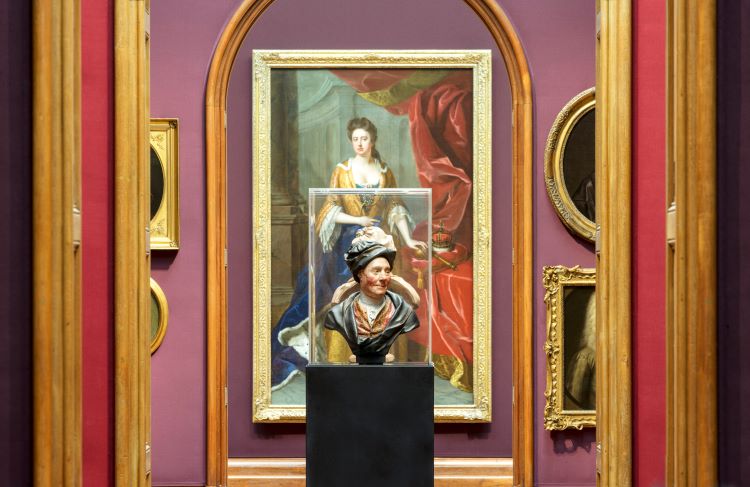National Portrait Gallery reopens after £41 million regeneration project
Wool-clad walls and restored vistas seek to better frame the portraits in the newly renovated National Portrait Gallery.
The National Portrait Gallery will reopen tomorrow following a three-year £41 million regeneration project, showcasing its new identity, wayfinding system and interpretation design and gallery rehang.
In addition to Edit Brand Studio’s new identity for the Gallery, Nissen Richards undertook the interpretation design, Jamie Fobert Architects carried out the architectural changes and Holmes Wood designed the wayfinding system.

Visitors will notice the changes from the outset with the new Ross Place entrance and forecourt, which reorients the building and allows more light in. The three windows on the façade have been transformed into doorways, with doors created by artist Tracy Emin, featuring 45 low-relief bronze panels that represent women through time.
The gallery rehang responds to audience feedback that called for a more “inclusive and dynamic picture of the people who have contributed to the history of the United Kingdom”, the National Portrait Gallery says. It has increased the proportion of portraits of women in the 20th and 21st century galleries from 35% to 48%, and in addition, 11% of all of the works on display are now of ethnic minority sitters, up from 3% before the regeneration, according to the Gallery.

An additional three-year project, Reframing Narratives: Women in Portraiture, is a collaboration with Chanel Culture Fund, which also seeks to increase representation in the National Portrait Gallery.
New audio-visual elements developed by software company NGX AV also seek to fill in contextual gaps where representation cannot be achieved through the portraits alone. While they provide opportunities “to understand more about the context of a key work or hear a behind the scenes story”, Nissen Richards director Pippa Nissen says she was keen to make sure the AV elements were “really integrated with the overall gallery furniture”, so the studio opted to use the same “patinated metal”.

There are now only two rooms throughout the National Portrait Gallery without natural light, as original windows and rooflights have now been reopened; where necessary, window covers have been applied to protect the art from light damage.
Original doorways have also been restored, revealing vistas that allow visitors to view portraits from interesting angles and distances. These changes also let visitors see the full effect of the colourful walls when looking straight through three or four gallery spaces at once.

The upstairs galleries walls are clad in coloured wool, which Nissen explains are coloured to signify each time period, acting as a kind of “natural wayfinding” method throughout the gallery. Pre-1850 portraits are hung on wool by Gainsborough Silk Weaving Company in bespoke colours. Nissen says the wool material “doesn’t reflect light”, and so “feels like natural pigment”.
Galleries housing portraits from earlier periods make use of darker, more muted tones of the wool, reflecting the colouring of the painting themselves. Brighter hues of green, coral red and blue are brought in as visitors travel chronologically through time, with these chosen to enhance the colours in the paintings.

At the centre of the floor, Jamie Fobert Architects’ opening of doorways allows for “a short enfilade through a series of colours, so that for the visitor this is looking across time”, says Nissen. The Duveen Wing, which shifts to a slightly later architectural style, is bolder with black marble detailing, leading to the final space with “a multi hang, deep red, dramatic wall colour and display”, she explains. Nissen Richards’ approach here was inspired by techniques used in the Thorvaldsens Museum in Copenhagen.
“Ultimately the display is all about the portraits on display”, says Nissen, “so the colours, cases, and frames should all recede but just create as much connection as possible to the works”.

Smaller areas called Making Galleries have been introduced, demonstrating the processes behind the art, from the creation of miniatures and Tudor panel painting to early photography techniques.
Nissen adds that a huge aspect of the gallery is the display lighting, designed by Studio ZNA, which is “hidden and seamlessly brings out the works themselves”.
Holmes Wood project lead Helen Cornell says that the guiding principle for the wayfinding was “to create timeless designs that were respectful to art and architecture”. It aims to be “understated, functional, accessible and discrete”, while also helping to “improve visitor footfall and drive opportunities to generate income, thereby safeguarding the future of the National Portrait Gallery”, she adds.
-
Post a comment





